The Future of HR: Top Predictions That Came True for Small Businesses
It’s hard to believe predictions and prophecies. All the same, sometimes we wish that crystal balls and psychics were real so that we know what to expect in the future. This carries over to the business world, where foresight can make or break a company.

If only seeing the future was this easy
Businesses with vision and a future plan often succeed when they work towards long-term goals. These companies differentiate themselves by charting out plans and timelines based on market trends and anticipating issues as well as solutions. In many ways, having foresight and acting on it are key to succeeding as a business.
Small and midsize businesses, especially, can learn much from enterprises on how to plan at least 5-10 years ahead. Foresight also requires paying close attention to predictions of industry-wide trends.
In the past five years, Gartner has made predictions about the HR software landscape that have been realized in 2016 and 2017. Many of these predictions are relevant to both enterprises and SMBs.
In this article, we review the top Gartner predictions for human capital management software that are most relevant to SMBs. We also look at some cases where the predictions came true and benefited companies.
Here’s what we’ll cover:
Prediction #1: Workforce Analytics Help You Evaluate Employee Performance
Prediction #2: Internal Recognition Drives Employee Morale
Prediction #3: Smart Workspaces Allow for Greater Collaboration
Prediction #1: Workforce Analytics Help You Evaluate Employee Performance
Workforce analytics are tools to track the performance of HR processes and HR-specific investments. They help HR and business leaders determine business strategies, especially for recruiting and employee engagement. This enables analysis by employee segments, which provides better performance measurement and managerial support.
Gartner prediction: “Adoption for workforce analytics will grow over time as business leaders recognize the impact of sophisticated workforce analytics to drive HR program investment decisions, and their ability to analyze and model the potential workforce-related costs and risks as they relate to strategic investments, divestitures, or emerging digital workplace initiatives.”
Source: Gartner’s “Hype Cycle for Human Capital Management Software,” 2014 (content available only to Gartner clients)
Business value: As an example, to understand why employees quit or feel disengaged, HR teams can analyze various data sets, such as feedback on the leadership, PTO trends, employee engagement levels and payroll data. Analytics can help SMBs create business plans that minimize their risk of failure.
Case Study: Human Capital Management
Google was one of the early adopters of this trend, and has been using workforce analytics for at least a decade to understand the best traits for a successful team. Here’s how they did it:
Pre-implementation: Some teams at Google were very successful while others lagged behind. So, in 2012, the company decided to understand the dynamics of successful teams so as to implement them in other teams. It sought to emulate the most desirable team behaviors across the company to increase productivity.
Post-implementation: Google’s People Analytics team studied 180 teams and attributes, such as common traits of the best managers, which rewards motivated people and tracks whether team members shared similar educational backgrounds. They also looked at traditions, behavioral standards, team culture and even the frequency of productive employees having meals with different groups.
After two years of collecting and analyzing all the tangible and intangible data, Google came up with five attributes that successful teams have in common:
Dependability of team members to get work done
Clearly defined roles and goals for each member and the team
Personal significance of the work to each member
Positive impact of the work being done and contribution to the greater good
Psychological safety from being always judged or made to feel incompetent
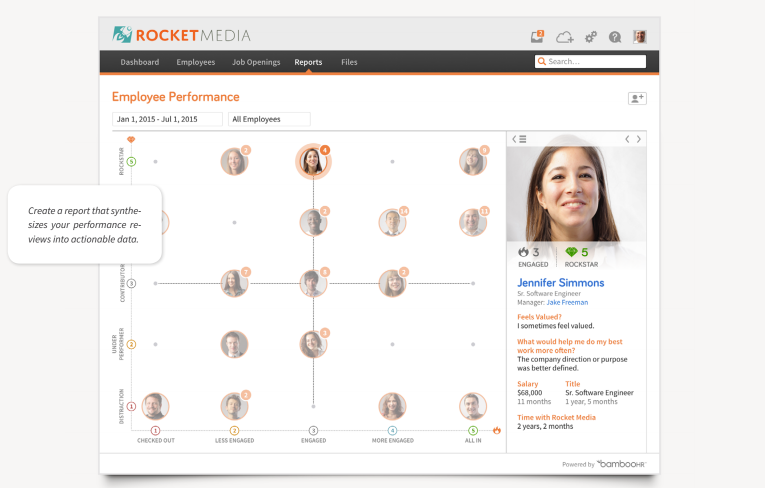
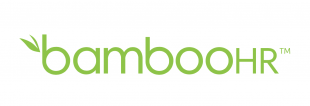
Employee engagement analysis in BambooHR (Source: BambooHR)
OUR RECOMMENDATION: Gartner’s “Predicts 2014: Nexus Forces Redefine Human Capital Management” report predicted that only 15 percent of enterprises will be using workforce planning analytics by 2017 due to lack of trained HR professionals. Another factor is companies’ inability to combine various data sources, such as payroll, absence data, recruiting and even social media data.
That’s why you need technically skilled HR staff that understands workforce analytics and makes decisions based on the generated insights. They need to work with the leaders and IT to create employee-focused business plans. They also need the right tools such as BambooHR, UltiPro, Workday and Cornerstone OnDemand.
Prediction #2: Internal Recognition Drives Employee Morale
Many HR vendors offer social recognition features within their suite. Badges, “likes” and points (also known as gamification) can help keep employees engaged and increase their morale.
The solution is particularly relevant to Generation Z (i.e., the generation born after 1994) and millennial workers. This new generation of the workforce thrives on ongoing feedback, not once-a-year reviews.
Gartner prediction: “Formal performance reviews will not disappear, but will instead increasingly leverage real-time, continuous crowdsourced feedback. … implement social performance tools alongside traditional performance processes and evaluate the results of each.”
Source: Gartner’s “Predicts 2014: Nexus Forces Redefine Human Capital Management” (content available only to Gartner clients)
Business value: HR should integrate social recognition and reward programs with performance reviews to better engage employees. Regular feedback helps younger employees assess themselves and improve where needed.
Small businesses have the advantage of designing their programs with help from their employees. This would ensure greater acceptance and participation, which in turn can boost the use of the reward system in your organization.
In addition, such programs make your company attractive to Gen Z and millennials because they value organizations that recognize their employees’ small and major successes.
Case Study: Employee Recognition
Here’s an example of a taxation company that wanted a social rewards and recognition module so that their employees could compete for awards.
Pre-implementation: As many employees were unable to meet their target numbers, the company wanted to encourage competition with a social rewards program. It wanted employees to set their own “SMART goals,” which would be tied to the company’s performance management solution. The company also required mobile access—a necessity for tech-savvy employees.
Post-implementation: When the company contacted our advisors, we suggested talent management solutions instead of performance management software to implement the social recognition program. Talent management software offers a wider gamut of features. It takes care of an employee’s performance, learning progress, engagement levels, social recognition and career progression plan.
Also, the integrated learning management feature means that if employees don’t meet their numbers, they can take a particular course to boost their skills. This functionality helps them perform better and progress on the company’s leaderboard.
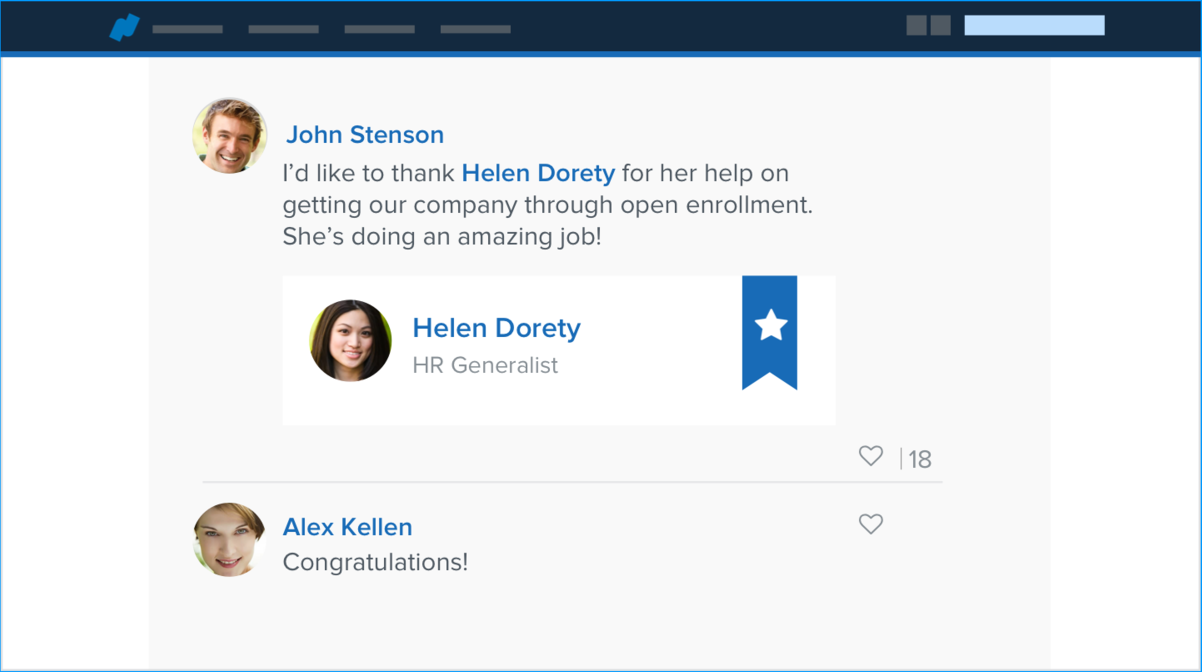
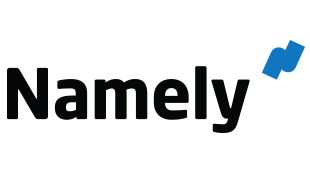
Social recognition of employees (Source: Namely)
OUR RECOMMENDATION: Some day, social recognition may replace the dreaded annual review cycle. But, you can’t ditch your assessment and compensation practice with social recognition. Instead, make social recognition an integral part of assessment that influences bonuses. Namely, Lanteria HR, Performly and Small Improvements are three of the suites that offer employee reward management programs.
Gartner’s “Hype Cycle for Human Capital Management Software, 2014” report predicted that one way to ensure engagement is through gamification. The more interactive your solution is, the more your employees will use it, and gain benefits in the short and long term.
Prediction #3: Smart Workspaces Allow for Greater Collaboration
With every aspect of our lives taking on a digital component, and the ubiquity of the internet, workspaces are evolving for greater online and physical collaboration. The Internet of Things (IoT) allows seamless integration between various devices, meaning you can sign-in using your mobile device or start a project on your desktop and finish it on the iPad.
Smart workspaces transform meeting rooms, cubicles, office spaces, homes and mobile devices into a digitally facilitated collaborative environment. They combine emerging technology trends such as IoT, digitized business processes, artificial intelligence, digital business architecture and the digital workplace. These trends influence employee performance, create new work models and boost efficiency.
Gartner prediction: “Smart workspace will trigger its own form of consumerization (“bring your own thing”), as employees will add their own objects to a smart workplace environment. Automation impacts are broad, related to costs, efficiencies and business effectiveness.”
Source: Gartner’s “Hype Cycle for Human Capital Management Software, 2014” (content available only to Gartner clients)
Business value: Workspaces should evolve to offer greater online and physical collaboration. Gartner’s “Top 12 Emerging Digital Workplace Technologies” article points out that technologies used by employees outside of work can be adopted in the workplace via seamless integration of various devices. Here are some technologies that companies should look to adopt by 2020, at least, in an infographic:
Bürolandschaft: The German term refers to the office landscape, i.e., developing or using employee scheduling software to handle remote work and encourage collaborative spaces in the office building.
Ambient knowledge: Extracts information from numerous employee sources using natural language processing and machine learning.
Immersive technology: Refers to wearable technology such as virtual reality (VR) headsets, smartwatches, fitness trackers and augmented technology.
Read analytics: Pushes access to big data analytics to the employees in a bid to make better, data-driven decisions.
My pet AI: Use of a virtual personal assistant (VPA) like Siri or Google Allo to learn from the individuals.
Personal cloud: Use of employees’ personal apps that can be used for professional purposes as well, such as LinkedIn to look up leads.
Silo buster: Refers to using collaboration tools that allow ideation, crowdsourcing, hackathons etc., which break traditional team structures.
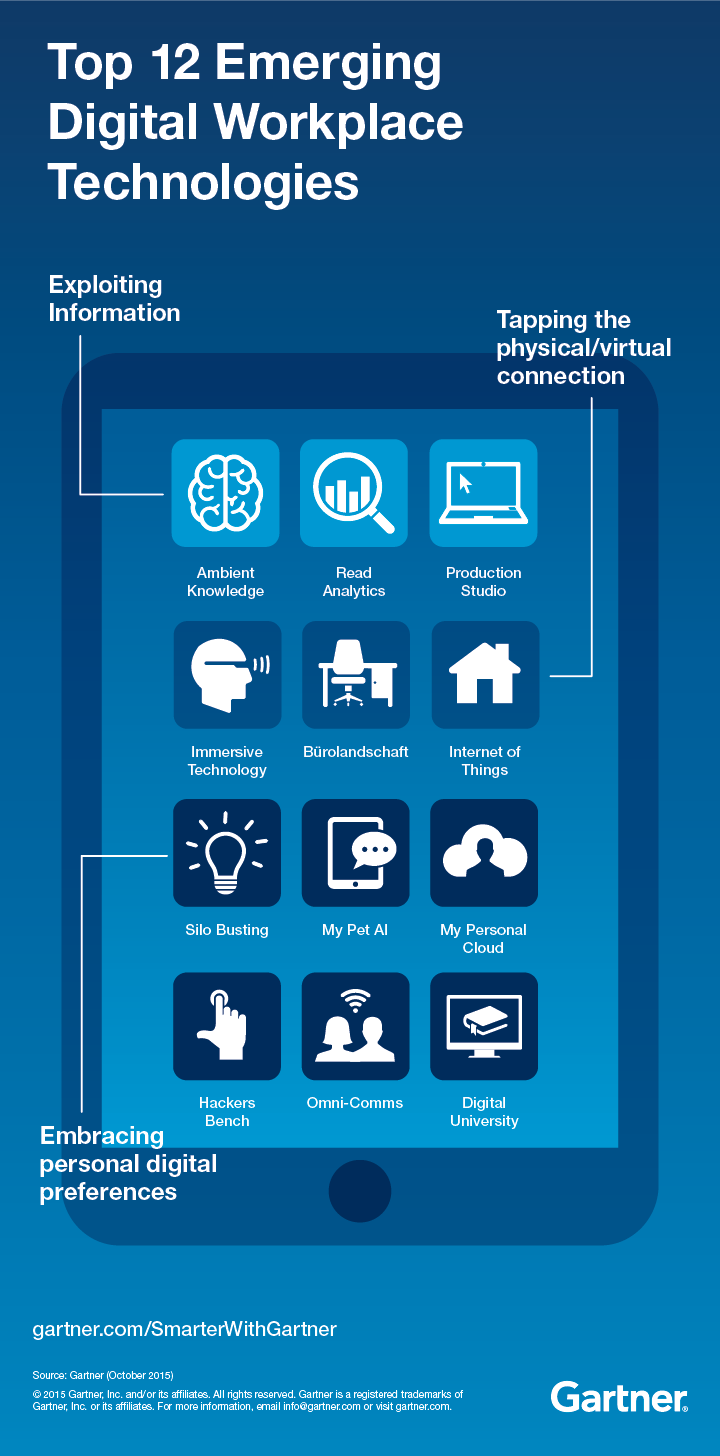
Source: Gartner
Case Study: Smart Workplaces
Here’s an example of how to create a smart workplace on a tight budget by encouraging a bring your own device (BYOD) culture to track employees and work status:
Pre-implementation: Sometimes, managers want to track employees (i.e., their location, assigned work, availability etc.) to update workflows, implement emergency services and note attendance/absence. However, manually tracking employees isn’t effective. Time cards can be tampered with and biometric systems are expensive.
Post-implementation: Many employees own smartwatches, VR headsets, fitness trackers, Bluetooth earphones and at least one type of smart sensor. That’s why it makes business sense to employ these devices at work.
Smart watches could let employees sign into work, receive alerts/updates when they are offsite and even communicate. A VR headset would allow you to have a virtual meeting from anywhere while fitness trackers could help companies determine insurance premiums. This would be extremely helpful—as health affects productivity, companies should invest in promoting healthy lifestyles, bodies and mindsets.
Tracking devices can be lifesaving in some industries, such as construction and travel, to track employee location and prevent any accidents. According to the US Department of Labor’s OSHA (Occupational Safety & Health Administration), companies lose $60 billion in productivity every year due to injuries and illnesses. Knowing your employees’ exact status could help avoid such incidents and expenses.
OUR RECOMMENDATION: Gartner’s “Hype Cycle for Human Capital Management Software 2014” report advises businesses to assess processes that can be digitized before they implement smart workspace technologies. This will require automating many different processes to gain the maximum benefits from IoT.
For example, insurance companies can use a digital pen for signatures that’s directly integrated to the back-end systems. Meanwhile, health monitoring wearable devices would allow medical professionals to assess patient health remotely, analyzing whether or what kind of medical attention the patient needs.
Conclusions and Next Steps
While this report looks at three specific predictions, this isn’t an exhaustive list. We selected these predictions because they’ve been adopted by both enterprises and SMBs. Here’s how you can gain maximum benefits now and ensure that your business isn’t late in adopting them:
Look at what the competition is doing: This makes it easy to assess your position in the market. Many SMBs stop at implementation due to costs, labor and time constraints. So, analyze which of these trends you need to adopt immediately. They’re complementary HR needs, so you can’t avoid them, only prioritize. Check out some of the vendors and their solutions to see how it’ll benefit your business.
Emulate the enterprise, but keep expenses low: Many enterprise businesses take time to create solutions in-house or customize one if no vendor fits their requirements. This means investing in additional resources or diverting your employees’ working hours from their regular tasks, which hampers productivity and costs. If you opt to customize, implement one feature at a time instead of the whole suite. Start with workforce management features, such as social recognition and analytics. Once employees become familiar with these processes, make organization-wide changes required to set up smart workspaces.
Partner with other startup/small businesses: Technology isn’t always cheap, which is why you should consider teaming up with upcoming vendors and startups. For example, the city of Plantation in Florida teamed up with Marathon Health for a health wellness program that resulted in 68 percent of city employees working to reduce symptoms such as high blood pressure, high cholesterol and high blood sugar levels. Such partnerships and joint ventures will allow you to add/customize features and capabilities that differentiate your business and services from the competition.
To get a better understanding of human resources software functionality and features, we recommend you read the buyer guide. If you’re looking to get a comparison of tools, then you can call us at (844) 675-2849 for free consultation with a software adviser.